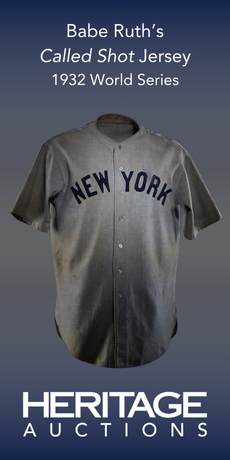
By Judy Carmack Bross

Cora Sheibani
“I like colour and then I like the shape and form and contrast of things..,I’m inspired by the freedom that not everything I design has to make sense.” –Cora Sheibani
The Swiss-born, London-based jewelry designer Cora Sheibani, extolls her Chicago roots, telling us early in our conversation about her grandmother who was born here, and the pleasure of having an intern from Chicago, Daphne Bulley, working with her in London this summer.
 Chicagoan Daphne Bulley worked as an intern for Cora Sheibani this summer and models Sheibani jewels in this article.
Chicagoan Daphne Bulley worked as an intern for Cora Sheibani this summer and models Sheibani jewels in this article.
Known for jewelry that is equal parts whimsical, including representations of clouds, pastries and plant pots as well as architectural and surreal. She exhibits at the Louisa Guinness Gallery in London where works by contemporary artists mingle with jewelry by modern masters as well as in many cities around the world. Her pieces are made almost exclusively in Switzerland, Germany, Italy and France, by goldsmiths of the highest caliber.
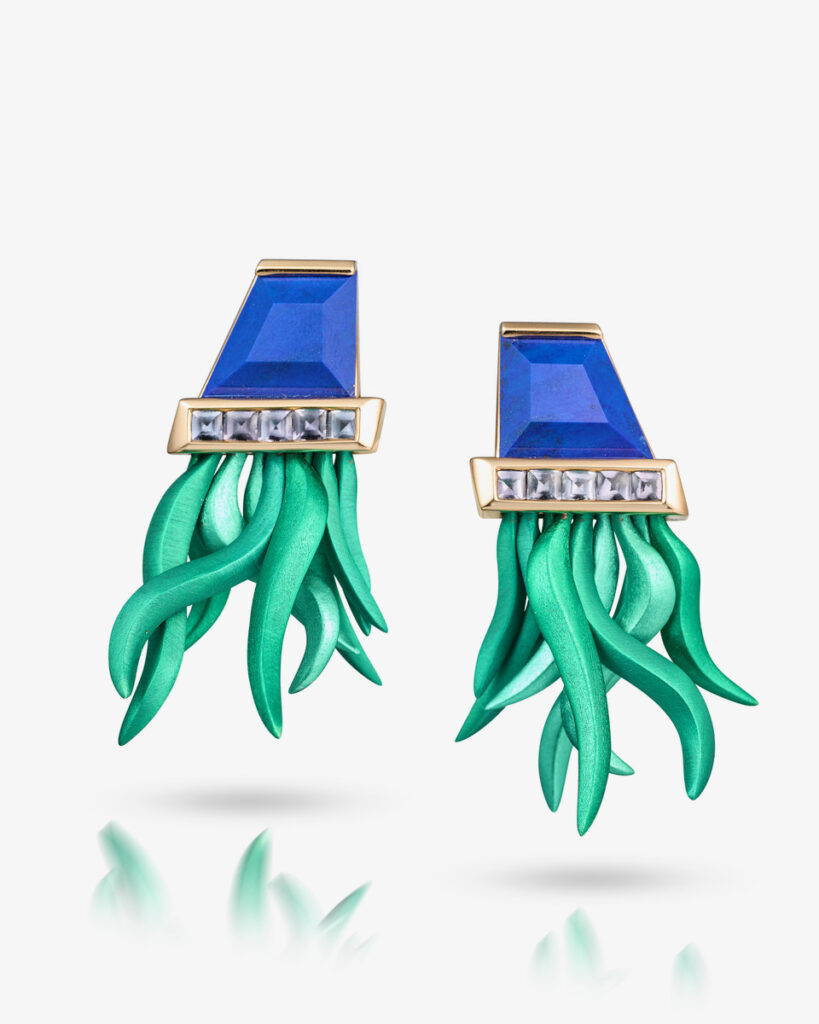
Large Fern Earrings
To celebrate the 20th anniversary of her work, William Grant, who wrote Andrew Grima: The Father of Modern Jewelry, authored Cora Sheibani Jewels, where he notes: “Cora Sheibani’s jewels are the product of a highly active imagination. Her creations are designed to surprise and delight.”
Bob Colacello, former editor of Interview, writes in the book’s foreword: “Cora’s creations are made with a sense of play as well as great invention and craft.”
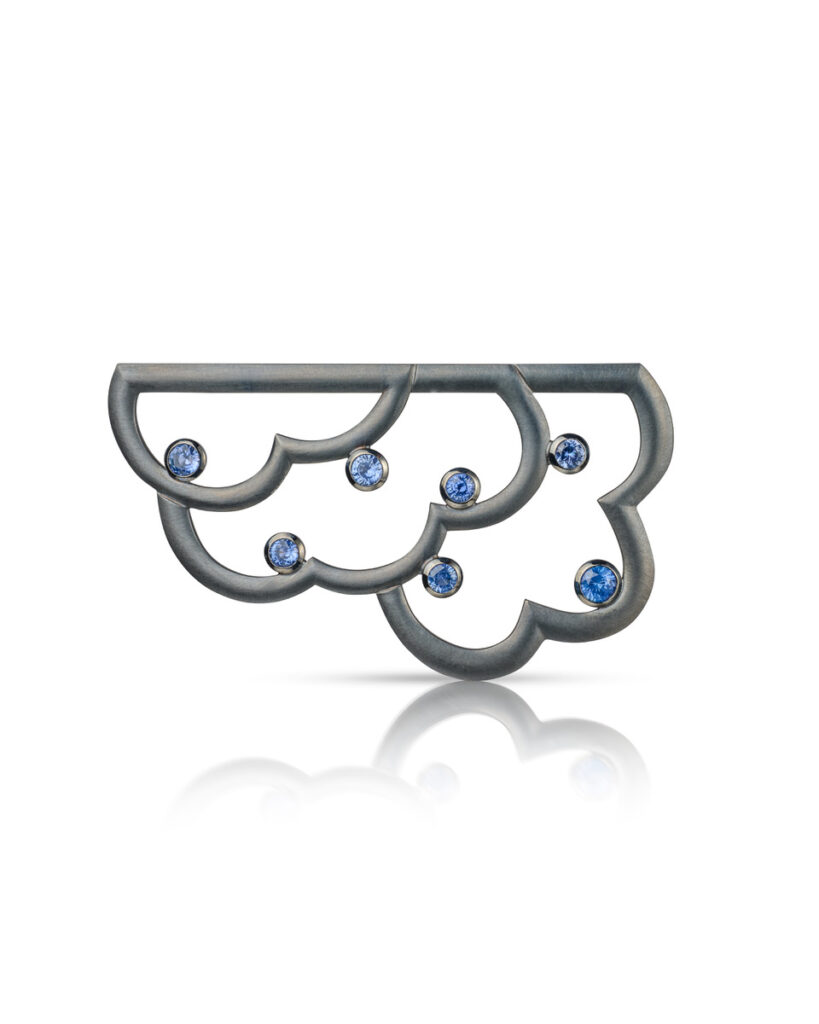
Cloud Broach
“I like cooking and baking and now gardening, and these things have naturally entered my jewelry universe,” said the designer and New York University Art History graduate who once wrote a cookbook featuring her own recipes to go along with a jewelry line.
The daughter of prominent Swiss art dealers and collectors, Sheibani recalls Jean-Michel Basquiat ask her to paint with him in the family garage when she was four years old. Also as a toddler she attended a gallery show her father hosted for Andy Warhol, and a photo of this event appears in the book on her work.

Sheibani shared her vision with us:
CCM: Your maternal grandmother was from Chicago. Has she said anything about being there as child? Was she an influence on you in your creativity and your love of jewelry?
CS: My maternal grandmother, born: Ella Miller, then Ella Clifton and now Ella Marenzi, was born in Chicago in 1933 and moved to California in circa 1940 with her parents and older brother. Her father was a wagoner in the WW1 and he and his wife are buried in Veteran Cemetery in Los Angeles, a few blocks from where my Iranian born parents-in-law live today. My grandmother Ella lives in Austria now, where her second husband was from. She came back to Europe in 1952 with my grandfather, who was from Buffalo, and who got a job as a pilot at the newly founded Swissair.
She is a stylish woman and I learned from her how to put together an outfit, no matter what you have at hand, she could combine all sorts of things and make a great look. She loved to find a bargain in a second-hand store, something my daughter and I still enjoy doing today. She never wore much jewelry, how to wear jewelry I learnt from my mother. My other Swiss grandmother, Maria who was born in 1902, who was a dentist, and she wore a brooch on her silk dress every time I remember seeing her.
CCM: Where did you grow up and what were your favorite things to do as a child?
CS: I grew up in Zurich and during the holidays, both summer and winter, we went to St. Moritz where I am today. I love the mountains and given I have pale skin and red hair, the beach is not for me. I also love sports so it’s a lovely place for that too. Because my mother went to the Swiss, English and French schools in Zurich, she decided to send my three siblings and I to the English International school as it was the one she enjoyed best. So I grew up bi-lingual in a household filled with a love of art. My father is a contemporary art dealer and spent a lot of time travelling and looking at auction catalogues at the breakfast table. Art, of all periods and types, was the main topic conversation throughout my
childhood and museums were, where we went to when we had free time.

Fern Earrings
CCM: We have a major exhibit here in Chicago on jewelry from the 17th century forward at the Driehaus Museum, with pieces from Chicago collectors, and the premise is that jewelry is art, that it pushes the boundaries just as paintings and other art forms do. Do you see that in your creation and in the beautiful materials that you choose?
CS: My parents both taught us that all art forms are equal. Although my father mainly sold paintings, he felt a fashion designer, film maker, typographer or architect, and of course jeweler, were all equal. So I have never felt the need to be called an artist, as great jewelry is as great in my eyes as a great artist. To me an artist has less constraints, as art does not need to fulfil a function. Whereas I like to make jewelry that feels good to wear and flatters the wearer. So unlike an artist, I do a lot of problem-solving which I love. I don’t want my jewels to look good on a pedestal or display case, I want it to look good on a person. So I like to make jewelry, not art. I find jewelry that is art, that is not really made to be worn or that “wears the person” is not for me. Of course, I have no problem with others enjoying making jewelry, for example, as a way to have a dialogue about humanity, politics, gender or whatever, but it’s just not for me. I love nature’s creations, gemstones are nature’s wonders in color. I love not just color but also interesting shapes and juxtaposing materials and textures that we are not used to seeing together.
CCM: You mention your interest in Surrealism. How does that play into your work?
CS: I never thought of myself as liking surrealism more than other forms of art, but perhaps wearing some of my jewels is a bit surrealist: wearing clouds, a jelly or an upside-down pot and plant is surrealist?
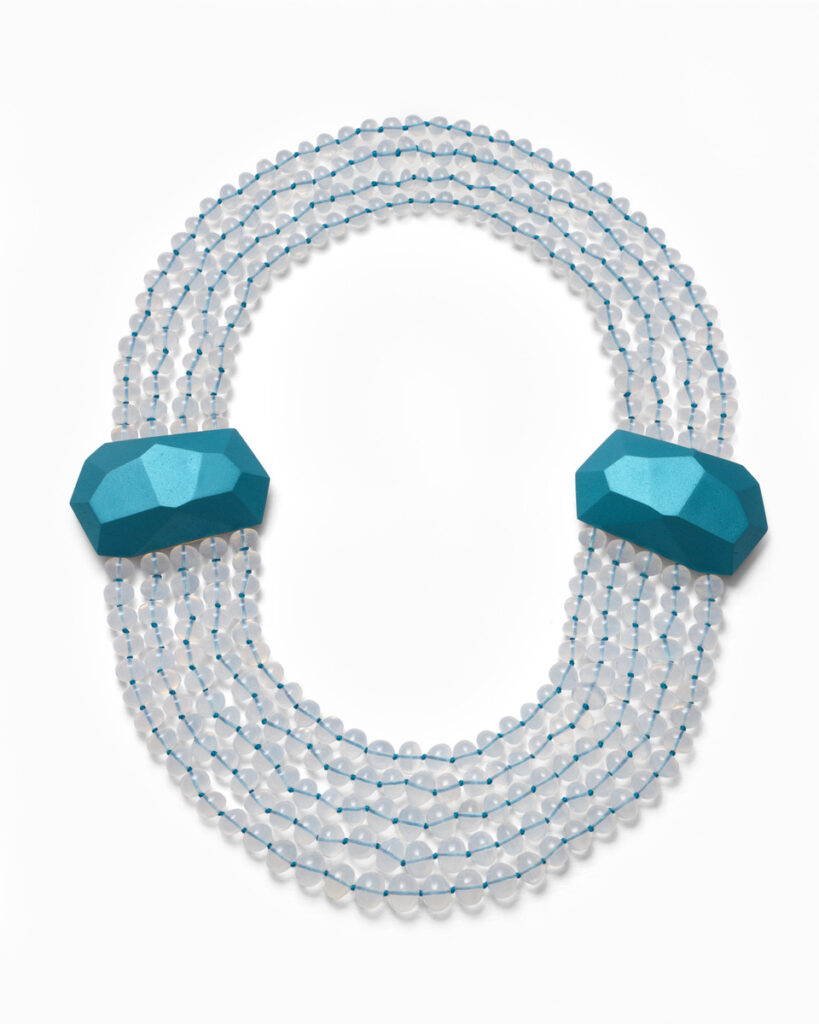
Moon Quartz Necklace
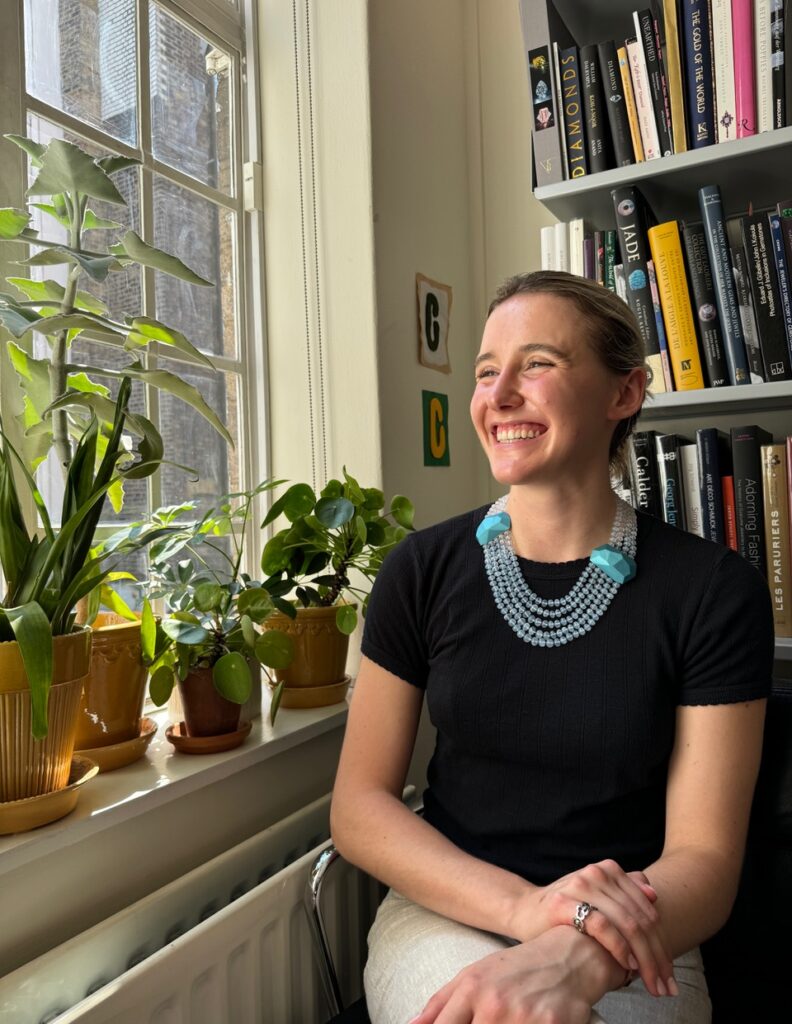
CCM: And the influence of things you enjoy doing such as cooking and gardening and then how these appear in the beautiful and often whimsical creations that you do that are so marvelous.
CS: I am influenced by everyday things that surround me and such things inspire me, especially interesting shapes and colours. I love Clouds like I guess a lot of baroque artists did. I like pastries, jellies and cakes as they are a beautiful and creative way to “package” food. I wanted to do packaging design before jewelry. I loved graphic design but prefer 3D things. The first money I ever worked for was as a receptionist in my father’s gallery one summer. I spent half of my earnings on two bronze rings, one Roman and one Greek. I love history and I love science. I tried to recreate the patina of a thousand years in my own jewelry only to discover that scientists realized that adding a small amount of silicate to bronze means that rust/patina is never permanent.
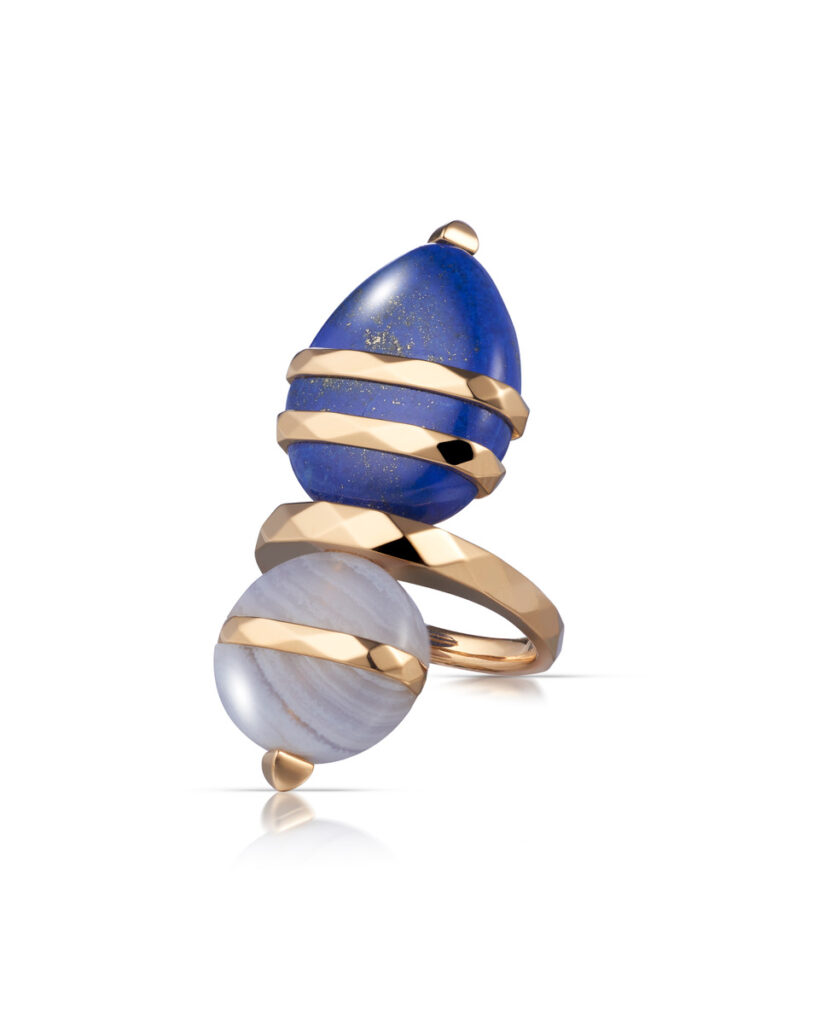
Cleo Ring
CCM: What is your design schedule? Do you have certain hours that you devote to creation of new pieces? Where do you do your work?
CS: I have no schedule, I used to be very productive when travelling on airplanes–before they installed wifi–but creating comes in waves. A commission often forces me to be creative and can lead to a new idea. My next collection was the result of a commission. It’s called Facets & Forms and is all about getting people to zoom into gemstones and appreciate the art of the lapidary who can cut a square gem in many different ways.
CCM: What does your pieces say about a person? How can a person best express themselves through what they wear?
CS: Some people wear jewelry as a status symbol, others for personal enjoyment. It’s easier for the wearer to enjoy jewelry than a dress. I feel like you need a mirror to appreciate an outfit, but all jewels except earrings, the wearer gets to look at it and enjoy it as much as the person who views her/him. I see the rings on my fingers all the time. I feel naked without wearing jewelry. I like high-quality craftsmanship but I prefer that the average person doesn’t recognize the value of what I am wearing. I favor understatement and I love great design. I like to feel stylish without showing off and that is the type of jewelry I like to create. A piece that is well-made, truly reflective of its time and worth keeping intact to pass down, rather than something a future owner would want to disassemble.

Cloud Collar Necklace
CCM: If a young person starting out a love affair with very special jewel such as yours, what would you advise them to buy if they could only begin with one piece?
CS: I think starting small is best, and the more you know and have seen the more you will know what makes sense for you. One good ring that I want to wear every day is a great thing. Having something only for special occasions makes more sense later in life.
CCM: What has been the hardest part of developing your business, and what have been the tenacious steps that you have taken?
CS: I think customs and insurance are the bane of my business. Because customs automatically think that jewelry could be part of money laundering etc., it is very costly and complicated to take jewelry over a border to sell or even just repair. It’s almost impossible for a small designer to do a trunk show abroad and make it viable. Thankfully I have a great team to help me with all this now.
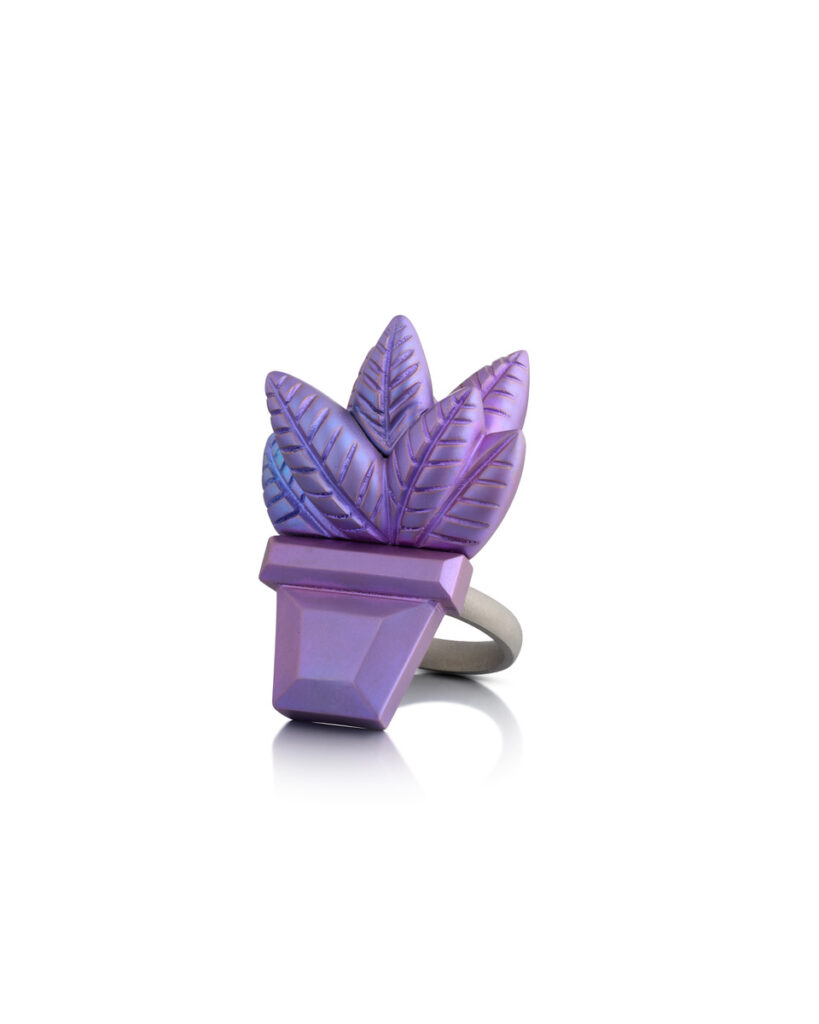
Fern Pot Ring
CCM: What advice do you have for artists who have a real vision and need to find their way?
CS: I think you really have to love what you do so that you keep at it and do not give up when things get tough. The world is so competitive, that if you do not believe in yourself, you have no chance. Remaining a little naive is a good thing too otherwise again you can lose confidence. Having your own business is not for everyone. Best is to design specific jewelry for a specific type of client. Know who you are designing for and stick with it…. take risks, be bold and above all have fun while you do it.





